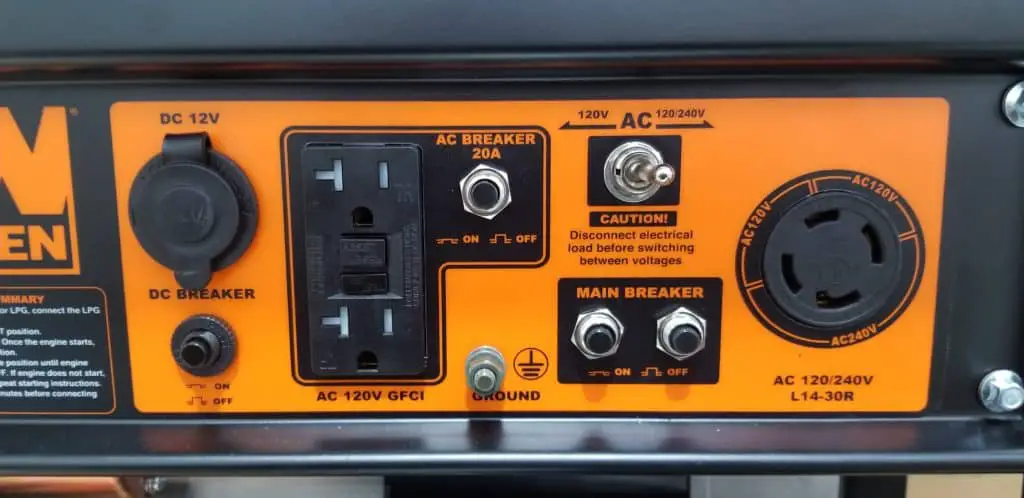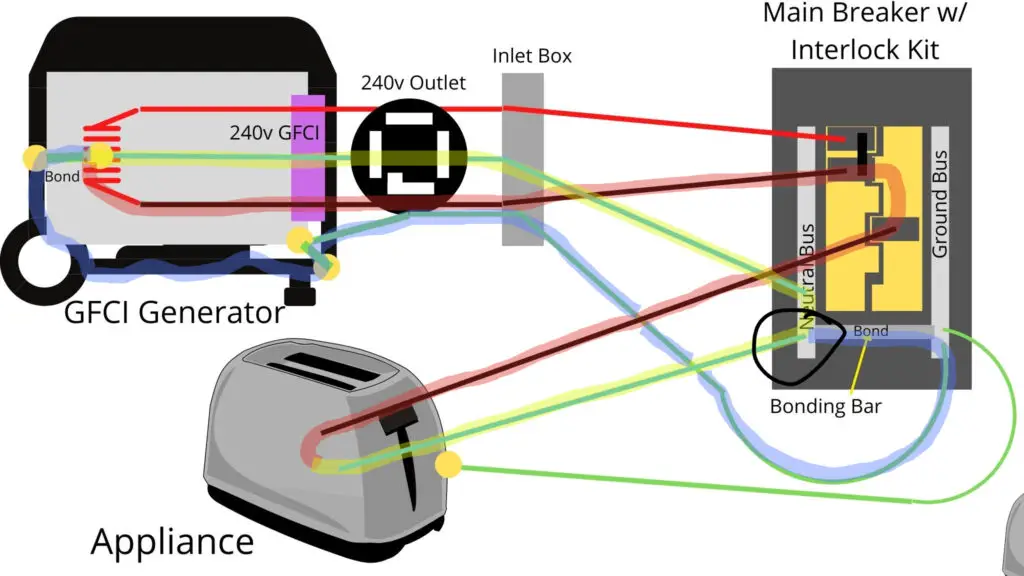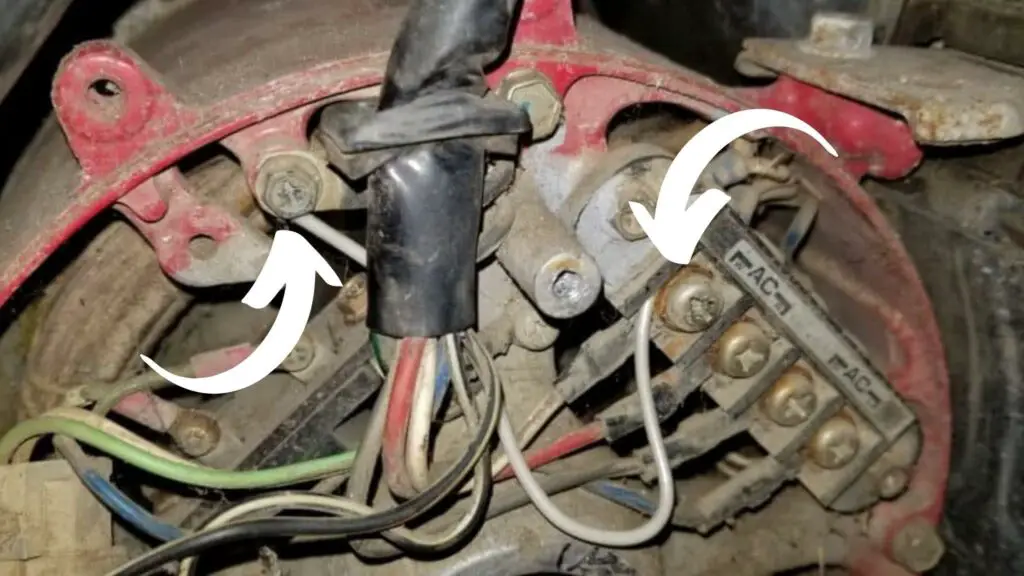With the exception of having your generator not start, the next most annoying thing your generator could do is have a GFCI breaker that trips every time you attempt to turn the lights back on.
This is a common problem if you have a generator where all of its circuits are GFCI protected and it can be fixed quite easily.
A very common reason for a GFCI protected generator tripping when backfeeding a house is due to the neutral and the ground being bonded on the generator itself. Combined with the bonding of the neutral and the ground at the house’s main panel, having two bonding points provides an alternate return path for the current which will always trip a GFCI breaker. Removing the bonding jumper on the generator will solve the issue.
Stick around and let’s briefly cover how a GFCI breaker works on your generator, why it keeps tripping, and how to stop your generator’s GFCI from tripping.
I’ve also got a video below where you can follow the path of the current, step-by-step, just in case you’re a visual learner like me.
Let’s jump into it!

How the GFCI Breaker Works on a Generator
GFCI breakers (Ground Fault Circuit Interrupt) primarily function by tripping (turning off) when there is an imbalance between the current leaving the breaker on the hot wires and the current returning back to the breaker on the neutral wire.
GFCI breakers are not simple mechanical devices. If you were to take one apart you would see a control board and electronics inside which regulate how the breaker physically performs.
To keep things high level, the breaker measures the output and the input. If they don’t match, then it trips (turns off).
If you were to power a toaster, for example, and 7 amps was leaving but only 5 were returning on the neutral, then the breaker would trip in a fraction of a second because it recognizes that current is being lost somewhere along the line.
GFCI’s are usually used around water, where if you drop something in the sink, for example, some of the return current will want to go back on the neutral but some of it will want to travel down the water, along your pipes, outside your home in the earth, through the earth to your home’s ground rod, back up the ground rod where it find the bonding point between the neutral and the ground, and once it jumps back to the neutral it completes the circuit.
Even though it completed the circuit, only a portion of the current traveled back through the neutral and through the GFCI breaker. The other current bypassed the GFCI breaker. Since there is now an imbalance, the GFCI trips nearly instantaneously.
I know, it’s hard without a visual, so let’s check that out below in the next section (or in the video in the previous section).
Why Does the GFCI Keep Tripping on a Generator?
There could be many reasons why a GFCI is tripping, but I’m primarily focusing on a single reason in this article because it’s such a common occurrence.
The GFCI on a generator will typically trip (turn off the power) while backfeeding a house when the generator itself has a neutral to ground bond. Since the house is already bonded, this creates parallel paths back to the source of the power (the generator) and with an imbalance of current on the hot and neutral wires due to some of the current flowing back on the ground wire, the GFCI will always trip.
That sounds like a mouthful, right?
Don’t worry, I’ve got you covered. Sometimes it’s easier to see things visually and I created a video below where you can follow the path of the current and see what I’m talking about.
If you’re choosing not to watch the video, I’ll do my best to explain.
For this scenario we have a generator that is bonded. This means that the neutral circuit ties up with the ground circuit at one place on the generator (typically under the alternator cover and not downstream of the GFCI breaker). This means that emergency fault current (if a hot wire were to come loose and energize the frame of your toaster, for example) would be able to travel down the ground wire, link up with the neutral, complete the circuit by bypassing the GFCI breaker, but allow the breaker to sense that something is wrong because of the imbalance and trip.
As the generator backfeeds the house, it sends out power through the internal coils, through a GFCI breaker, and then through the 220-volt receptacle.
The GFCI receptacle, as we learned earlier, has a control module inside (and more, but we’re keeping this simple) that monitors the current flowing on the hot wires and the neutral. Everything must balance out between the hots and the neutral in order for the GFCI to stay functional.

Once the power flows through the cord and into the inlet box on the house, it then powers the transfer switch (the result would be the same with an interlock kit and the power directly feeding to the main breaker box).
From there, it energizes both of the 120-volt breaker busses (120-volt + 120-volt = 240-volts).
Circuits run to pre-selected appliances from the transfer switch (or the main breaker if you’re using an interlock kit).
Normally, current should now flow from the generator, through the cord, to the transfer switch, to the appliance, and through the hot and neutral wires (it depends on how many circuits you’re running and what their draw is, but they should all balance) all the way back to the generator to complete the circuit.
The issue arises when we realize that the transfer switch two wires (a ground and a neutral) that lead to the main breaker panel and join up with the corresponding busses. In the main breaker box, the neutral and the ground are also bonded.
This means that when you power your toaster, some of the return current will travel along the neutral straight to the generator like it should. However, some of it will also travel up through the neutral to the transfer switch, jump over to the main breaker box, jump over to the ground via the bond with the ground, and travel back on the ground wire where it bypasses the GFCI on the generator (since it’s not downstream of the GFCI) but still completes the circuit at the generator’s bonding point.
Since a portion of the current didn’t return through the GFCI and instead took the ground wire back, the GFCI will immediately trip.

In fact, this will happen so fast that the breaker will trip as soon as you hook it up to the house and try to power anything. You won’t even get a chance to power anything because it can sense this imbalance in a fraction of a second.
The presence of two bonding points in the same system creates this parallel path for the return current back to the generator and is what is causing the issue.
Without the second bonding point at either one of the locations, the return current would only travel back on the ground wire in the event of an actual fault and trip the breaker (which is what we would want it to do).
How to Stop GCFI From Tripping on a Generator
You should always consult with your local licensed electrician before making any changes to any electrical setup.
That being said, the primary issue with the aforementioned scenarios is that your system has a neutral-ground bond at two locations and there can only be one. Having two will always create parallel paths for the return current to travel back to the source.
I highly discourage tampering with the bond in your home’s breaker box.
The bond on the generator is typically what you’ll want to remove.

Each make and model generator will be different, but it’s not uncommon to find a jumper wire underneath the alternator cap on the back of the generator that connects the ground with the neutral.
Once this jumper is removed, the system will function perfectly and will no longer trip (assuming this was your issue in the first place).
